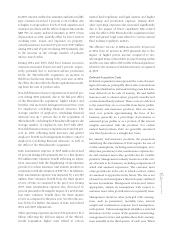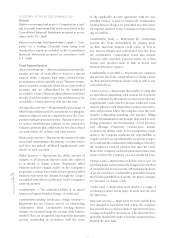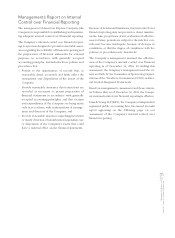American Express 2004 Annual Report Download - page 69
Download and view the complete annual report
Please find page 69 of the 2004 American Express annual report below. You can navigate through the pages in the report by either clicking on the pages listed below, or by using the keyword search tool below to find specific information within the annual report.
AEB had worldwide loans outstanding at December 31,
2004 of approximately $6.9 billion, up from $6.5 billion
at December 31, 2003. The following table summarizes
the composition of AEB’s loan portfolio by business
line as of December 31, 2004 and 2003.
Percentage of total loans
December 31, 2004 2003
Private Banking 48% 45%
Consumer 22 23
Financial Institution 29 29
Corporate Banking 13
In addition to the loan portfolio, other banking activi-
ties, such as securities, unrealized gains on foreign
exchange and derivatives contracts, various con-
tingencies and market placements added approxi-
mately $7.2 billion and $7.6 billion to AEB’s credit
exposures at December 31, 2004 and 2003, respec-
tively. Included in these additional exposures are rela-
tively lower risk cash and securities related balances
totaling $4.7 billion at December 31, 2004 and $5.4 bil-
lion at December 31, 2003.
Contingent Liquidity Planning
AEB has in place a contingent funding plan that enables
it to meet daily customer obligations during periods in
which its customers do not roll over maturing deposits.
This plan is designed to ensure that AEB could meet
these customer withdrawals by selling a portion of its
investment securities or by obtaining financing through
repurchase agreements.
Risk Management
AEB employs a variety of financial instruments in man-
aging its exposure to fluctuations in interest and cur-
rency rates. Derivative instruments consist principally
of foreign exchange spot and forward contracts, for-
eign currency options, interest rate swaps, futures and
forward rate agreements. Generally, they are used to
manage specific interest rate and foreign exchange
exposures related to deposits, long-term debt, equity,
loans and securities holdings. At December 31, 2004,
interest rate products with notional amounts totaling
approximately $11.6 billion for trading and non-trading
purposes were outstanding. Notional amounts out-
standing at December 31, 2004 for foreign currency
products were approximately $28.2 billion for trading
and non-trading purposes. Additionally, equity prod-
ucts with notional amounts of $582 million were out-
standing at December 31, 2004.
The negative effect of a 100 basis point increase in
interest rates on AEB’s pretax earnings would be $44
million and $42 million at December 31, 2004 and 2003
(including the impact on pretax earnings related to the
joint venture with AEFA), respectively. The effect on
earnings of a 10 percent change in the value of the U.S.
dollar would be immaterial and, with respect to trans-
lation exposure of foreign operations, would result in
a $7 million and $9 million pretax reduction in equity
as of December 31, 2004 and 2003, respectively.
AEB utilizes foreign exchange and interest rate products
to meet the needs of its customers. Customer positions
are usually, but not always, offset. They are evaluated in
terms of AEB’s overall interest rate or foreign exchange
exposure. AEB also takes limited proprietary positions.
Potential daily exposure from trading activities is calcu-
lated using a VaR methodology. This model employs a
parametric technique using a correlation matrix based
on historical data. The VaR measure uses a 99 percent
confidence interval to estimate potential trading losses
over a one-day period. The average VaR for AEB was
less than $1 million for both 2004 and 2003.
Asset/liability and market risk management at AEB are
supervised by the Asset and Liability Committee, which
comprises senior business managers of AEB. It meets
monthly and monitors: (i) liquidity, (ii) capital expo-
sure, (iii) capital adequacy, (iv) market risk and
(v) investment portfolios. The committee evaluates
current market conditions and determines AEB’s tactics
within risk limits approved by AEB’s Board of Direc-
tors. AEB’s treasury and risk management operations
issue policies and control procedures and delegate risk
limits throughout AEB’s regional trading centers.
CORPORATE AND OTHER
Corporate and Other reported net expenses of $238
million, $214 million and $176 million in 2004, 2003 and
2002, respectively. Net expenses increased during 2004
primarily due to increased corporate investment
spending on compliance and technology projects and
increased interest expense on debt issued in late 2003
in the Parent Company. Included in 2002 results were
the final preferred stock dividends from Lehman Broth-
ers totaling $69 million ($59 million after-tax).
OTHER REPORTING MATTERS
Accounting Developments
See Recently Issued Accounting Standards section of
Note 1 to the Consolidated Financial Statements.
AXP
AR.04
67
Financial Review
























